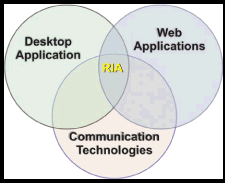Rich Internet Application

The term RIA (Rich Internet Applications) refers to web applications that have the features and functionality of traditional desktop applications, it means Rich Internet Applications are a cross between web applications and traditional desktop applications that shift some of the essential processing among the bulk of the data for the user interface to the Web client while rest of some remain on application server.
In the Rich Internet Application, the term ?Rich? stands for the broad range of media includes multiple fonts, vector and bitmap graphic files, animations, online conferencing, audio and video. It sooths to the eyes and the materials are more catchy due to its richness medium. e.g. any picture in the flash is more attractive than ordinary still picture.
Usually a Rich Internet Application runs in a Web browser. It does not need the installed software. It runs locally in a sandbox that provides a secure environment.
Origin of RIAs
Before transforming in its in original name RIA had been exist in several names and forms. For example: Remote Scripting, X Internet, Rich Web clients and Rich Web Application.
Microsoft exposed the initial name of Remote Scripting in 1998, while Forrester Research recalled it with ?X Internet? in October 2000. Later it is also known as Rich Web client and Rich Web Application.
The term ?Rich Internet Application? was first introduced in March 2002 in a Macromedia white paper.
Rich Internet Application Vs. Standard Web Applications
Traditional web applications processed all activity around client-server architecture and a thin client. All the processing held on the server, while client only displays static content in case of being HTML content. Passing all the interaction through the server that is required to reload the data is the biggest drawback of this system because all interactions with the application

have to pass through the server that is unnecessary and lowers the processing speed. On the other hand, RIAs can dodge this slow and synchronous loop for many user interactions. This difference is rather similar to the difference between ?terminal and mainframe?

and Client-server/Fat client approaches.
As the development of Internet standards have held gradually but continuously according to turning time, it is very difficult to draw a strict line between the composition materials of an RIA.
But one characteristic is similar in all RIAs as they introduce an intermediary layer of code between the user and the server that is often known as a client engine. It acts as an extension of the browser and generally downloaded at the beginning of the application that can be supplemented by further code downloads as the application progresses. The client engine usually takes over responsibility for rendering the application?s user interface and for server communication. In most RIAs the client engine performs additional asynchronous communications with servers.
